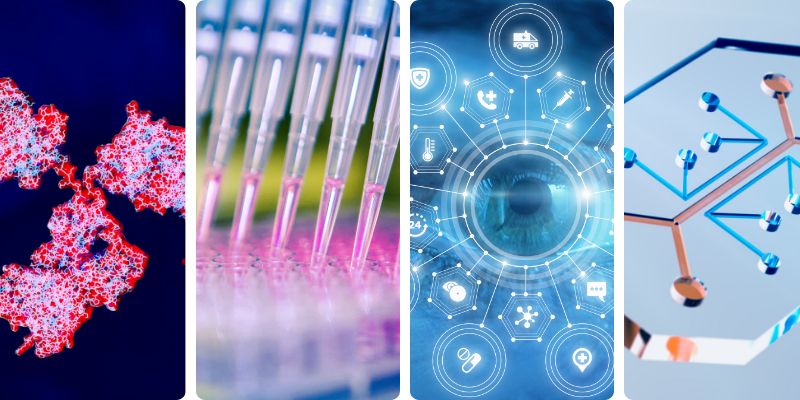
CN Bio at the 2023 OBN Awards, MIMETAS and Yamaha Motor, the tiny biological robots from human cells of the Wyss Institute
News on non-animal methods
Dec. 4 - Dec. 8, 2023CN Bio named winner with most impactful industry collaboration
CN Bio, an organ-on-a-chip (OOC) company that designs and manufactures single-and multi-organ microphysiological systems (MPS), has received the ‘Most Impactful Industry Collaboration of the Year’ at the 2023 OBN Awards.
The award recognises the ongoing success of the company’s collaboration with the US Food and Drug Administration (FDA), aimed at advancing OOC adoption through evaluation of its PhysioMimix OOC range of MPS across a series of applications in drug discovery and development.
Around 90% of drug candidates reaching clinical trials fail, often due to poor clinical translatability between conventional animal models and humans. Coupled with increasing awareness around ethical considerations and the increasing cost of animal studies, there is growing interest in New Approach Methodologies (NAMs), such as OOC, to provide effective, predictive preclinical models.
MIMETAS and Yamaha Motor Sign Joint Marketing Agreement to Advance Automated Human Disease Model Applications for Drug Development
MIMETAS, a leader in human 3D disease modeling, and Yamaha Motor Co., Ltd., a developer of the CELL HANDLERTM, announce a strategic joint marketing agreement aimed at advancing therapeutic development using human-relevant models throughout the early drug development pipeline.
The collaboration combines MIMETAS’ comprehensive disease modeling and assay development expertise with Yamaha Motor’s state-of-the-art CELL HANDLER, an automated system for selecting, picking and imaging spheroids, tissues and organoids.
Scientists from the Wyss Institute build tiny biological robots from human cells
Researchers from the Harvard University’s Wyss Institute for Biologically Inspired Engineering have created tiny biological robots, called Anthrobots, from adult human tracheal cells that can move across a surface and encourage the growth of neurons in a lab dish. The multicellular assemblies, ranging in size from the width of a human hair to the point of a sharpened pencil, are designed to carry out tasks depending on the functions of their individual cells and how they work together. The discovery is a starting point for the researchers’ vision to use Anthrobots as new therapeutic tools for regeneration, healing, and treatment of disease.
“The cellular assemblies we construct in the lab can have capabilities that go beyond what they do in the body,” said Levin, who also serves as the director of the Allen Discovery Center at Tufts. “It is fascinating and completely unexpected that normal patient tracheal cells, without modifying their DNA, can move on their own and encourage neuron growth across a region of damage,” said Levin. “We’re now looking at how the healing mechanism works, and asking what else these constructs can do.”
The advantages of using human cells include the ability to construct biobots from a patient’s own cells to perform therapeutic work without the risk of triggering an immune response or requiring immunosuppressants. They only last a few weeks before breaking down, and so can easily be re-absorbed into the body after their work is done.
Organoids Evolve from Academic Marvel to Industrial Tool
Organoid technology can be traced back to early dissociation-reaggregation experiments.
Today, organoids can be derived from pluripotent or tissue-resident stem cells or progenitor or differentiated cells from healthy or diseased tissues, and there are various organoid engineering strategies that support organoid culture and growth, proliferation, differentiation, and maturation.
In addition, as this article emphasizes, the production of organoids is being carried out at ever greater scale, opening up a range of applications.
In some cases, it’s already possible to scale up the production of organoids.
In late 2022, Molecular Devices gained that capability through the acquisition of Cellesce, a company that specialized in large-scale organoid production.
“We focus primarily on adult stem cell – derived organoids,” says Vicky Marsh Durban, PhD, director of custom organoid services, Molecular Devices, “but our platform technology is applicable to any type of organoid, as long as it grows in a gel matrix, because our bioreactor processes are optimized for growing organoids in gel matrices rather than in suspension.”
To industrialize organoids, though, scale is not enough.
“The biggest thing that we’ve kept in mind is really getting the scale without destroying the models,” Durban says.
“The models are inherently quite sensitive and are more complex than the standard two-dimensional models.” Ensuring that so many organoids maintain the desired features depends on quality control.
Advances on pediatric brain organoids and heart organoids
More accurate pediatric brian organoids produced by the Hubrecht Institute
Essential features of the cortex, an important part of the human brain and its development, are more accurately captured in organoids generated by researchers of the Hubrecht Institute and Princess Máxima Center
for pediatric oncology. The researchers developed mini-organs with features like cell organization, stem cell expansion and cell identity that more closely mimic the real-life situation. These novel organoids can be used as a basis to model pediatric brain tumors.
Multiple childhood brain tumors, like cortical gliomas, arise from the cortex, the outer layer of the largest part of the brain, and the brain’s most expanded structure.
(…) Research into a better understanding of how brain tumors arise and develop could help researchers in finding possible targets for treatment. (…) The current study was led by dr. Benedetta Artegiani, research group leader at the Máxima Center and Delilah Hendriks, Oncode-researcher in the Organoid group at the Hubrecht Institute and affiliated group leader at the Máxima Center and published today in Nature Communications. The new cortex organoid that the researchers generated more closely represents the human brain in multiple aspects : their shape, their architectural organization and several properties of their cells.
Multi-chamber heart organoids by the Institute of Molecular Biotechnology (IMBA) of the Austrian Academy of Sciences
The human cardioid platform recapitulates the development of all major embryonic heart compartments, including right and left ventricles, atria, outflow tract, and atrioventricular canal.
Headed by Sasha Mendjan, PhD, the IMBA team reported on their development in Cell, in a paper titled, “Multi-chamber cardioids unravel human heart development and cardiac defects.”
The developers suggest the technology will help scientists generate a screening platform for use in drug development, toxicology studies, and to help understand heart development.
Heart organoids developed from patient-derived stem cells could, in the future, give insight into the developmental defect and how it may be treated and prevented.
The Mendjan group is particularly interested in using multi-chamber heart organoids to understand heart development further. “We now have a basis to investigate the heart’s further growth and regenerative potential.”
U of T ‘self-driving lab’ to focus on next-gen human tissue models
The Self-Driving Laboratory for Human Organ Mimicry is one of six self-driving labs launched by the Acceleration Consortium to drive research across a range of fields.
The University of Toronto is home to a new “self-driving lab” that will allow researchers to better understand health and disease – and to more rapidly test the efficacy and toxicity of new drugs and materials.
Based at the Donnelly Centre for Cellular and Biomolecular Research, the Self-Driving Laboratory for Human Organ Mimicry is the latest self-driving lab to spring from a historic $200-million grant from the Canada First Research Excellence Fund to the Acceleration Consortium – a global effort to speed the discovery of materials and molecules that is one of several U of T institutional strategic initiatives.
The new lab will be led by Milica Radisic, Canada Research Chair in Organ-on-a-Chip Engineering and professor of biomedical engineering in the Faculty of Applied Science & Engineering , and Vuk Stambolic, senior scientist at the Princess Margaret Cancer Centre, University Health Network, and a professor of medical biophysics in the Temerty Faculty of Medicine.
Scientists 3D print human skin with hair follicles. It could transform medical and cosmetic research
Recently, Pankaj Karande, an associate professor of chemical and biological engineering at Rensselaer Polytechnic Institute
in New York, and his team 3D printed hair follicles within lab-grown human skin tissue. It’s an unprecedented development that could transform many fields. Lab-grown skin can help us find treatments for diseases, heal wounds, spare animals from cosmetic testing, and perhaps even design “leather” that emulates the look and feel of real animal hides.
(…) To unlock the full potential of lab-grown skin, the engineering needs to mimic natural skin as closely as possible — hair follicles included. Hair follicles play crucial roles in thermoregulation, sweat production, and skin healing, thanks to their stem cells. They also act as gateways for topical drugs and cosmetics.
“Our work is a proof-of-concept that hair follicle structures can be created in a highly precise, reproducible way using 3D-bioprinting. This kind of automated process is needed to make future biomanufacturing of skin possible,” Karande, study lead author, said in a press release.


